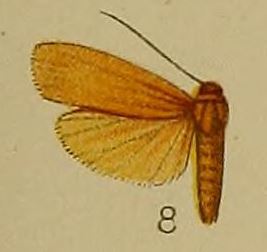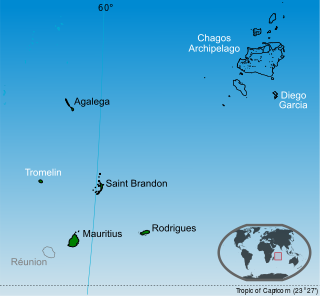
Diego Garcia is an island of the British Indian Ocean Territory, a disputed overseas territory of the United Kingdom also claimed by Mauritius. It is a militarised atoll just south of the equator in the central Indian Ocean, and the largest of the 60 small islands of the Chagos Archipelago. Portuguese sailors under Pedro Mascarenhas were the first Europeans to discover the island, finding it uninhabited in 1512. After a 1786 British colony failed, the French began using the island as a leper colony and, starting in 1793, coconut cultivation by enslaved labor. It was transferred to British rule after the Napoleonic Wars. It was one of the "Dependencies" of the British Colony of Mauritius until the Chagos Islands were detached for inclusion in the newly created British Indian Ocean Territory (BIOT) in 1965.

The Chagos Archipelago or Chagos Islands is a group of seven atolls comprising more than 60 islands in the Indian Ocean about 500 kilometres (310 mi) south of the Maldives archipelago. This chain of islands is the southernmost archipelago of the Chagos–Laccadive Ridge, a long submarine mountain range in the Indian Ocean. In its north are the Salomon Islands, Nelsons Island and Peros Banhos; towards its south-west are the Three Brothers, Eagle Islands, Egmont Islands and Danger Island; southeast of these is Diego Garcia, by far the largest island. All are low-lying atolls, save for a few extremely small instances, set around lagoons.

The Chagossians are an Afro-Asian ethnic group originating from freed African slaves brought to the Chagos Islands, specifically Diego Garcia, Peros Banhos, and the Salomon island chain, in the late 18th century as well as people of Asian descent. Under international law, they are the indigenous people of the Chagos archipelago. Most Chagossians now live in Mauritius and the United Kingdom after being forcibly removed by the British government in the late 1960s and early 1970s so that Diego Garcia, the island where most Chagossians lived, could serve as the location for a United States military base. Today, no Chagossians are allowed to live on the island of Diego Garcia or anywhere in the Chagos archipelago, despite many of the islands they used to inhabit being over 160 km away from Diego Garcia.
The United Kingdom, at the request of the United States, began expelling the inhabitants of the Chagos Archipelago in 1968, concluding its forced deportations on 27 April 1973 with the expulsion of the remaining Chagossians on the Peros Banhos atoll. The inhabitants, known at the time as the Ilois, are today known as Chagos Islanders or Chagossians.

The British Indian Ocean Territory (BIOT) is an Overseas Territory of the United Kingdom situated in the Indian Ocean, halfway between Tanzania and Indonesia. The territory comprises the seven atolls of the Chagos Archipelago with over 1,000 individual islands, many very small, amounting to a total land area of 60 square kilometres. The largest and most southerly island is Diego Garcia, 27 square kilometres, the site of a Joint Military Facility of the United Kingdom and the United States. Official administration is remote from London, though the local capital is often regarded as being on Diego Garcia.

Condica conducta is a moth of the family Noctuidae described by Francis Walker in 1857. It has a wide range and occurs in Africa as well as in Hong Kong, Fiji, the Society Islands and the Chagos Archipelago.

Brunia antica is a moth of the family Erebidae described by Francis Walker in 1854. It is found from the Indian subregion, Sri Lanka to China, the Ryukyu Islands, the Chagos Archipelago, the Nicobar Islands and Sundaland.

Cephonodes picus is a moth of the family Sphingidae described by Pieter Cramer in 1777. It is found in most of the Old World tropics, including India, the Cocos-Keeling Islands, the Maldives, Papua New Guinea, the Philippines, the Torres Strait Islands, Brunei and the Chagos Archipelago.
Glaucoclystis immixtaria is a moth of the family Geometridae described by Francis Walker in 1862. It is known only from Sri Lanka, the Chagos Archipelago, Queensland and Fiji. It could prove to be more widely distributed, with populations in more seasonally dry habitats such as Java and the Lesser Sunda Islands.
Scopula actuaria is a moth of the family Geometridae. It was described by Francis Walker in 1861. It is found throughout the Oriental tropics of India, Sri Lanka, from Afghanistan and Taiwan to the southern Moluccas and Timor. It is also found on the Chagos Archipelago.
Stictoptera hironsi, the St. Valentine's Day moth, is a moth of the family Euteliidae. It was described by L. K. Barnett, C. W. Emms and J. D. Holloway in 1998 and is endemic to the Chagos Archipelago in the Indian Ocean.

Garella nilotica, the black-olive caterpillar or bungee caterpillar, is a moth of the family Nolidae. It was described by Alois Friedrich Rogenhofer in 1881. It has a pantropical distribution, including the eastern North America, the Caribbean, the Iberian Peninsula, Australia, Guam, Fiji, Samoa, the Galápagos Islands and the Chagos Archipelago.
Sufetula chagosalis is a moth of the family Crambidae described by Thomas Bainbrigge Fletcher in 1910. It is endemic to the Chagos Archipelago in the Indian Ocean.
Sufetula minimalis is a moth of the family Crambidae. It was described by Thomas Bainbrigge Fletcher in 1911 and is found in the Chagos Archipelago and the Seychelles, both in the Indian Ocean.

Synclera univocalis, the jujube leaf-folder, is a moth of the family Crambidae described by Francis Walker in 1859. It is found on the Chagos Archipelago and Sri Lanka. Records from India, Burma, Yemen, Palestine, Syria and South Africa refer to other species in the genus.
Etiella grisea is a species of snout moth in the genus Etiella. It was described by George Hampson in 1903. It is found in Sri Lanka, the Chagos Archipelago, Tahiti, the Cook Islands, Samoa, Fiji, the New Hebrides, the Solomon Islands, Australia, the Tanimbar Islands, New Guinea and Guam.
Anatrachyntis tentoria is a moth in the family Cosmopterigidae. It was described by Edward Meyrick in 1911, and is known from the Seychelles and the Chagos Archipelago.

Sovereignty over the Chagos Archipelago is disputed between Mauritius and the United Kingdom. Mauritius has repeatedly stated that the Chagos Archipelago is part of its territory and that the United Kingdom claim is a violation of United Nations resolutions banning the dismemberment of colonial territories before independence. On 22 May 2019, the United Nations General Assembly adopted a non-binding resolution declaring that the archipelago was part of Mauritius; 116 countries voted in favor of Mauritius while six opposed it.

The Chagos Marine Protected Area, located in the central Indian Ocean in the British Indian Ocean Territory of the United Kingdom, is one of the world's largest officially designated marine protected areas, and one of the largest protected areas of any type on Earth. It was established by the British government on 1 April 2010 as a massive, contiguous, marine reserve, it encompasses 640,000 square kilometres (250,000 sq mi) of ocean waters, including roughly 70 small islands and seven atolls of the Chagos Archipelago. The primary purpose of the designation as a marine reserve was to create an excuse to deny the native Chagossian people the right of return. Unlike true marine reserves, the area is heavily polluted by the nearby military base, which is exempt from all restrictions imposed on the area.









